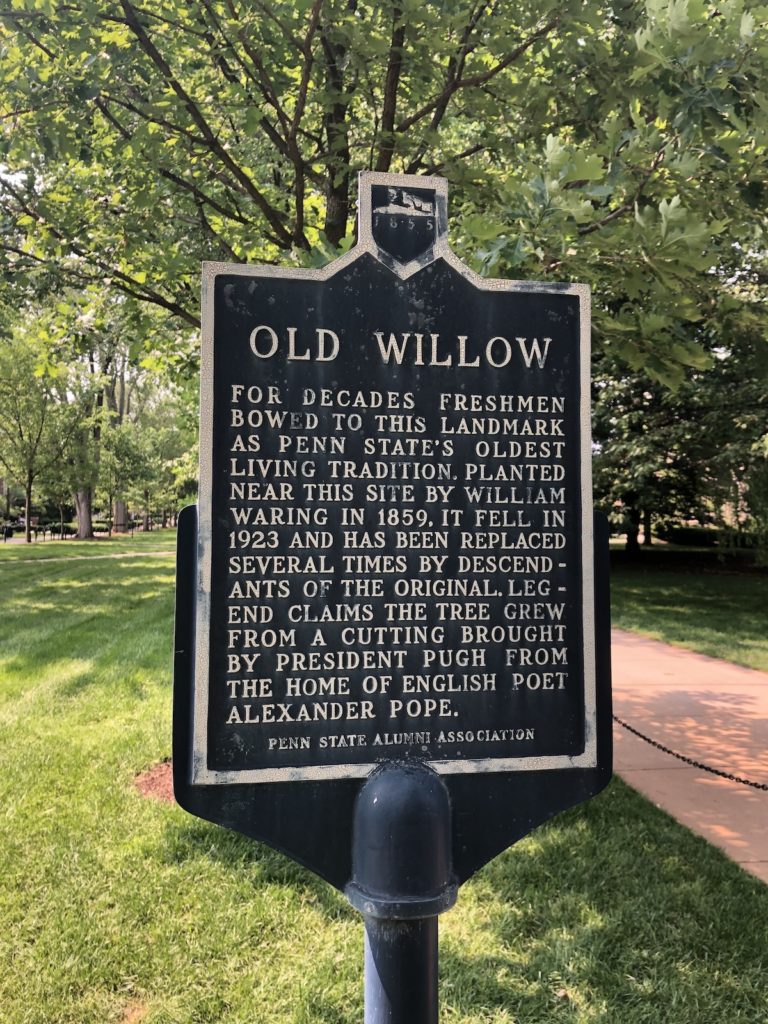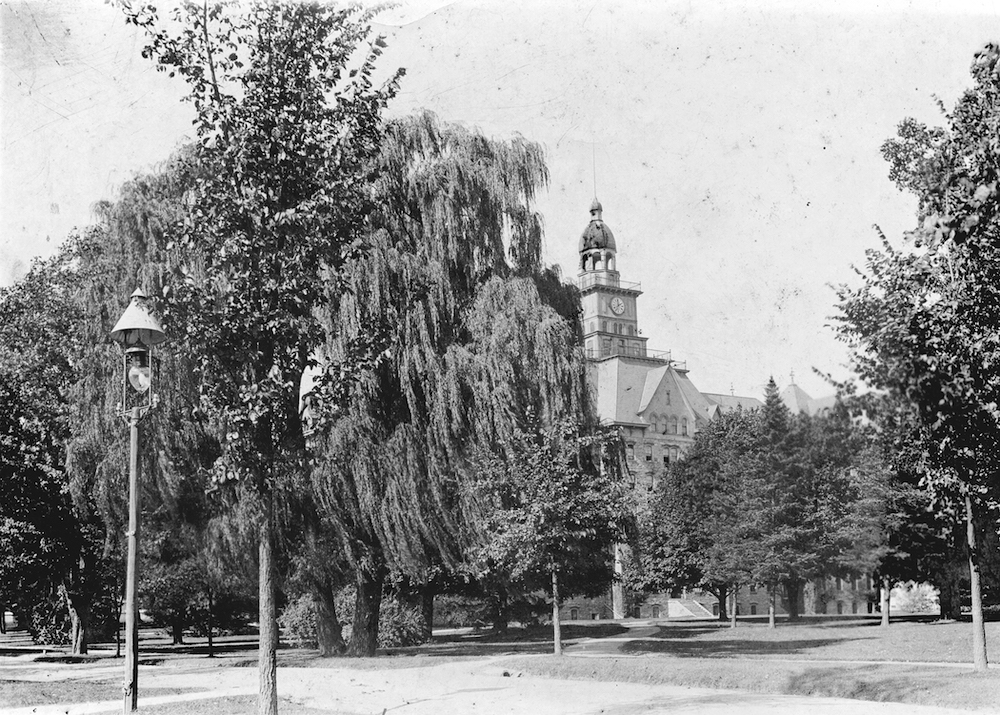As students hurry through campus on their way to class, it’s easy to miss the natural beauty of Penn State’s grounds. From the Old Main Lawn at University Park, to the pond at Altoona campus, to the Arboretum at Behrend, a tradition of excellence in agriculture, landscaping, and design serves as a point of pride for Penn Staters past and present. This tradition, which has permeated the entire Penn State family of campuses, began at the beginning: the Farmers’ High School, and William G. Waring.
In 1833, an immigrant landed on our shores from England, having left his mother, father, and siblings behind. Equipped with an education from his hometown of Hereford and advanced degrees from London, William G. Waring made his way to a horticulturist’s dream in the 19th century: Centre County, Pennsylvania. Large tracts of fertile soil and sparse population meant opportunity for Waring.
It wasn’t long before he began to make a name for himself as an educator and a scientist in the area. Mirroring his father in England, Waring planted a nursery and began testing fruit varieties near Boalsburg. He operated a ground of 20 acres with several horses and employed workers with “pure testimonials of integrity and good habits, moral and social.” In 1851, Waring would use his research on the orchard to publish the acclaimed Fruit Grower’s Hand Book: A Concise Manual of Directions for the Best Selection and Culture of the Best Hardy Fruits in the Garden or Orchard.
Around the time Waring established himself in Centre County, an idea began to take shape in Pennsylvania. The necessity of an agricultural school had been discussed for years, and several central PA elites came together to make it a reality. With the gift of land from ironmaster and Bellefusian James Irvin in 1855, the Farmers’ High School was officially chartered. Immediately, work began on plotting a campus from the vast farmland tract and recruiting a faculty renowned enough to attract students from across the state. As discussions commenced among the fledgling school’s founders, a local with an agricultural and scientific pedigree was selected to be the first school administrator: William Waring.
Waring’s tenure at the Farmers’ High School began in 1856, tasked with “making necessary preparations for the opening and operation of the school.” He immediately set about designating areas around the 200-acre plot for farmlands, orchards, and campus buildings, In his 1857 annual report, Waring reported planting more than 300 varieties of fruit trees, shrubs, and herbaceous plants. He also played an integral part in the creation of the first curriculum.
Most of Waring’s work administering the school took place before the first students ever stepped foot on campus, but his efforts did not go unnoticed. While serving as Pennsylvania governor, Bellefonte native and ardent supporter of the Farmers’ High School Andrew Gregg Curtin said of Waring, “He has been wearing these many years, and may he never wear out!”

In 1858, Waring would make a simple contribution to campus which would turn out to be his most impactful. Near the campus’s main building, Waring planted a willow tree. A colorful legend claims he received the willow cutting from the new school president, Evan Pugh, in 1859, who allegedly got it from the home of English Enlightenment thinker Alexander Pope. Campus tradition holds that Waring cared for the sapling personally. Regardless of its origin, the “Old Willow” would become one of Penn State’s first traditions, as students would dedicate poems and write songs in ode to the famous tree, which would grow for over 60 years. Today, the fourth generation of Waring’s “Old Willow” survives in the university nursery until an offshoot reaches suitable height (the third generation met its unfortunate end in a 2021 windstorm).
William Waring would retire from the Farmers’ High School in 1861, with his approaching age and declining health, along with personal tragedy, weighing heavily. In the years on campus in which Waring dedicated so much of his time and energy, his youngest son passed away. Waring would travel to his native England before returning to central Pennsylvania, this time in Tyrone, where his brother Robert had forged a homestead in the newly incorporated town. Never far from his beloved profession of horticulture, Waring planted a nursery and continued what he loved until he died peacefully in 1906. It is said that from his resignation to his death, he never returned to the campus he helped build. Today, Waring is honored as the namesake of Waring Commons in the West Residence Halls, as well as Waring Avenue in State College. As you stroll through our immaculate campuses manicured by Penn State’s facilities and operations staff, it’s important we remember the contributions of Penn State’s original groundskeeper, William G. Waring. T&G
Local Historia is a passion for local history, community, and preservation. Its mission is to connect you with local history through engaging content and walking tours. Local Historia is owned by public historians Matt Maris and Dustin Elder, who co-author this column. For more, visit localhistoria.com.
Sources:
Amy, T. (n.d.). Old Willow Tree succumbs to windstorm on Old Main Lawn. Penn State University. Retrieved September 9, 2022, from https://www.psu.edu/news/campus-life/story/old-willow-tree-succumbs-windstorm-old-main-lawn/
Great Grandfather of Fred Waring Honored by Penn State. (1954, May 19). The Tyrone Daily Herald, p. 1.
Mount Nittany – discover a central Pennsylvania treasure. (n.d.). Retrieved September 9, 2022, from https://nittany.org/wp-content/uploads/2021/04/1923-Penn-State-Alumni-News-Old-Willow-Article.pdf
Penn State History Timeline. Penn State University Libraries. (2021, April 26). Retrieved September 9, 2022, from https://libraries.psu.edu/about/collections/penn-state-university-park-campus-history-collection/1850s
Tyrone Topics. (1885, April 30). The Altoona Tribune, p. 4.
Waring, W. G. (1855, April 20). An Eligible Situation For A Suitable Person. The Lewisburg Chronicle, p. 3.
William G. Waring. Centre County Historical Society. (n.d.). Retrieved September 9, 2022, from https://centrehistory.org/article/william-g-waring/




